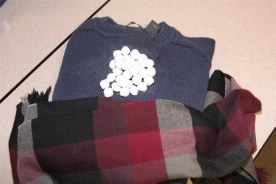EMBARGOED FOR RELEASE | March 22, 2010
Household pesticide labels lack details on safe use
SAN FRANCISCO, March 22, 2010 — Label directions for using some household pesticides are written in a way that may leave consumers with the impression that “if a little is good, more is better,” according to a study presented here today at the 239th National Meeting of the American Chemical Society (ACS). As a result, consumers may use excessive amounts of pesticides that could subject family members and pets to increased exposures.
In the study, Linda M. Hall, Ph.D., and colleagues found that minimum and maximum doses are clearly listed on labels for agricultural pesticides. Labels for a household pesticide such as para-dichlorobenzene mention the minimum amount for consumers to use, but don’t indicate the maximum amount to be used. Para-dichlorobenzene (pDCB) is the active ingredient in mothballs and other products used to protect silk, wool, and other natural fibers against moths and beetles; caged birds against lice and mites; and for mildew prevention. Hall is with the California Environmental Protection Agency.
Media Contact:
Michael Bernstein
m_bernstein@acs.org
415-978-3504 (Meeting, March 21-25)
202-872-6042 (Before March 21)
Michael Woods
m_woods@acs.org
415-978-3504 (Meeting, March 21-25)
202-872-6293 (Before March 21)
“Recently several national studies have shown that minority groups including African-Americans and Hispanics are likely to have elevated blood levels of a variety of indoor air pollutants,” Hall said. “Very important among these indoor air pollutants is pDCB, the moth ball ingredient. All uses of pDCB in California are residential. Therefore, it is important that labels clearly define conditions for safe use by untrained residential consumers.”
Their review of pDCB labels found that manufacturers specify a minimum rate of application (such as ounces or pounds per cubic foot of storage space) and a minimum treatment time, but no information on the maximum amount for safe use. “While this label sets conditions to protect against the pest insects, it allows consumers to follow the old adage, ‘if a little is good, more is better’! Thus, there is no limit on the amount that may be used per cubic foot of storage space. This might account, in part, for the high levels of pDCB seen among some consumers.”
Likewise, the study found that labels on moth control products specify a minimum treatment time, typically advising that clothing be treated in a closed container for 7 days. However, labels do not specify a minimum airing procedure to dissipate the pesticide that has seeped into the fabric.
“Thus, the consumer, following label instructions, might take clothing saturated with pDCB fumes directly from storage and wear it immediately,” Hall said. “Because no airing conditions are specified, consumers who find the pDCB odor unpleasant and do air clothing, might air it indoors, further contributing to human exposure to this substance.”
Hall said the public should be aware of the limitations of current label instructions in order to use pDCB products in ways that minimize exposures.
###


